Materials: epoxy resin, brass, silver, paint
Dimensions: 5" by 2 1/2" by 1"
A piece about the expectations of female roles.
this totemic mixed materials brooch holds a number of references to feminine form. The superhero figure has lost it's face (the face being a facade) and instead has a hand. The female visage is divided down the middle with a subtle hue change signifying the duality of roles from which women must often choose. And the blue bird? is is happy?
Well, that's what is expected.
Photo credit: MBZ
Maureen Brusa Zappellini
MBZ Metalsmith
Tucson, Arizona. USA
Having started my art career as a painter, color and texture tend to play leading roles in my design aesthetic.
I was introduced to metalsmithing during summers home from University, when I would apprentice for a silversmith in my hometown in the seacoast of New Hampshire.
Eventually I found myself to be intensely attracted to my metalsmithing, and that began my transformation into becoming a full time metalsmith. My foundations in painting often result in color and texture playing a large role in my work. I like to imagine my pieces to be small sculptural paintings, and the wearer is the mobile gallery.
I find inspiration in the world that surrounds me: specifically in found objects, natural forms, industrial design and architecture. Each piece I create is the result of playful visual exploration, experimentation with materials, and the application of techniques, both traditional and contemporary.
An artist responds to their materials with ideas. My mission is to find ways to make both sing. When my work makes me smile I know I'm on the right path; when it makes others smile I know I have reached my destination.
The exhibition explores metal works whose primary theme is color embraced as their primary visual focus, whether that be using colored materials, exploring creating colored surfaces, or encasing the object in color.
As the world's largest jewelry related internet site, Ganoksin strives to develop exhibitions showcasing work from around the world. This exhibition was open to all metalsmiths, professional and amateur, advanced and beginner.
In total 303 artists contributed 814 show pieces for the permanent online exhibition.
The exhibition was curated by Beth Wicker, President of the North Carolina Society of Goldsmiths in the United States, and Adjunct Instructor at Northeastern Technical College in South Carolina. Director of the exhibition is Hanuman Aspler, founder of The Ganoksin Project, the world's largest internet jewelry site.
Hue is one of the primary properties of color, it refers to the place the color occupies on the visual spectrum. Humans have used hues throughout time, to create cave paintings, to decorate themselves, their clothing and their housing.
Different hues have taken on different meanings throughout time. Gold traditionally has been a color of purity - the metal gold is relatively unchangeable, and the hue of gold has come to stand for gods and goddesses, for royalty, for durability and for purity. Red has often meant love, or passion. Hues often reflect the meaning of the seasons, with pastels referring to spring and the burst of new life after the pale hues of winter. Summer is reflected in vibrant, deep hues, followed by the browning of hues in the fall as plants go to seed and die, and the land turns fallow.
The worth of a hue has often been tied to what is necessary to make the pigment that creates the hue, and the expensive involved in the process. Often created from crushed stones that had to be mined and carried by caravan over thousands of miles, or from fermented roots of plants only grown in certain areas, or the carapaces of rare insects - the creation of hue in a way that could be used by man was an involved and generally expensive process.
In today's world metalsmiths have access to perhaps the widest range of materials and hues in the history of man - and in some of the most affordable ways ever.
This exhibition celebrates hue - color - as an integral, inherent element of the work. We talk of the "richness" of color, and examples of this abound here. One expects hues from the colors of gemstones used in metalsmithing, but we also have hues from some less expected places. Glass enamels are an ancient way of adding color, as are a variety of patinas. Today's artists also use synthetic man-made materials to add color in ways that didn't exist a century ago.
We invite you to enjoy this celebration of hue, and the ways hues and their use have changed over time.
